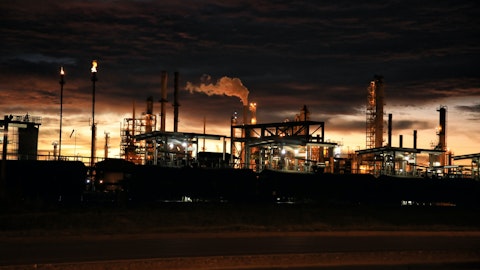Willie Chiang: And Spiro you are aware that we ended up with some weather problems in the back-half of June and July. It was really weather-related, hot weather, there were some gas plant issues and the producers have been very disciplined, not to flare. Also, we had a lower flat price in that period of time. So there is probably not as incentive — as much incentive to try to produce. So, we think we’re through that. Oil prices have been more constructive, highlighted by the OPEC decisions today with a little more support behind it. So as we think about the rest of the year we’ve incorporated all of this into our outlook on guidance. We actually have Permian guidance — volume guidance, just a little bit below our 500, but even with that, we still think we’re going to be at the high-end of the year — end of the range.
Brian Reynolds: Great. I appreciate all that color. And then maybe as a follow-up, can you just give us an update on the minimum volume commitments that are being worked through in 2023 . And how we should think about that as we look ahead into 2024, would those be fully worked through and could that be a tailwind as we think about 2024 early numbers. Thanks.
Jeremy Goebel: The way I would look at it is that there’s two pipelines that are accruing deficiency. I would say that the time period to work through those deficiencies, they’re still accruing some on the pipelines. So I would view it as something that’s going to take a few years to work through. Just because of the other commitments on the pipeline, you have to look at it as the — using deficiency credits is the last barrel that’s shipped, the barrels that are committed, shipped first, any spot barrels are next and then the deficiency. So from a capacity standpoint, working through the deficiency barrels on space available basis, so that takes time to get through. It will take probably a couple of years to do that.
Willie Chiang: And Brian, our outlook hasn’t changed. We still expect the spreads to strengthen as capacity shrinks with increasing production. As you probably know, we’ve chatted about on the Permian takeaway capacity of the Gulf Coast, we’ve essentially made sales and contracts to kind of protect that for the next — predominantly for this year and ’24. So that gives us a little bit of buffer, and we would expect that the rates between Permian and the Gulf Coast should expand out to ultimately incremental transportation costs.
Brian Reynolds: All makes sense. Appreciate the time. Enjoy the rest of your morning.
Willie Chiang: Thanks, Brian.
Operator: [Operator Instructions] The next question comes from Gabriel Moreen with Mizuho. Your line is open.
Gabriel Moreen: Hi, good morning, everyone. I was wondering if you can maybe speak to your CapEx outlook for this year in light of a little bit of the tweaking to the Permian outlook. You’re running a little bit late, I think, with your guidance, if you I guess, annualize it. So I’m just wondering, is there a possibility you’re coming a little lower end of the CapEx range given that Permian volume outlook?
Willie Chiang: Gabe, Chris Chandler will cover that. There’s a lot of work that we go through to keep capital discipline across the company. Chris?
Chris Chandler: Yes, good morning, Gabe. We do continue to optimize our spend for 2023. Speaking in buckets, for our gathering system projects, we’re pacing our investment timing with our customer schedules. And Willie mentioned some color there with leaving a period of some adverse weather and lower prices, we expect that to kind of pick up in the second half of the year. On Permian infrastructure investments, we do have complete projects as needed to match expected production growth in the different regions of the Permian. So we try to time that appropriately. And then remember, we just announced a new NGL project at Fort Sask and we’re going to be able to fund the 2023 portion of that project within our existing guidance of $325 million net to Plains for 2023. So there are some moving parts there, but we’re reiterating our current guidance for the year.
Gabriel Moreen: Understood. Thanks, Chris. And then maybe on this M&A deal and a little bit of a two-parter. One is, to what extent when you do these gathering deals within the JV, are you either extending or renewing further downstream commitments? I realize that may be a commercially sensitive question to ask and then just kind of lay the land in terms of getting more of these gathering acquisition? And kind of done at what it’s looking like.
Jeremy Goebel: Sure. The way I look at it is if we’re buying from a producer, generally there’s an improvement in the contractual relationship. We had one as being partners with them, but we converted it a bit to something that was more appropriate for us not being business partners and us being the owner and then being the shipper or the producer. So there is a — the terms were strengthened to reflect that relationship. We have a great relationship with Diamondback and look forward to growing with them in this area.




